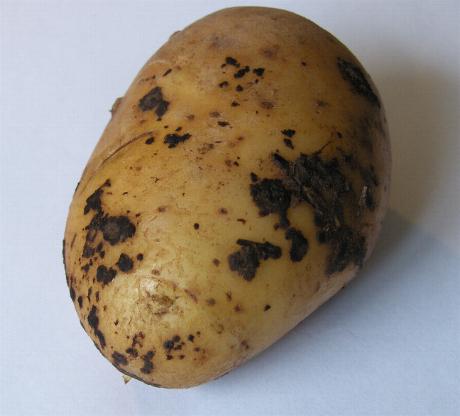
Sclerotia of Black Scurf on the skin of a potato.
Black Scurf is a fungal disease of potatoes and is caused by Rhizoctonia solani. It is usually found as irregular, black, scab-like marks on the skin of the tubers. They are easily scraped off with a fingernail and this releases a distinctive 'fungal' smell. These black masses are the resting phase of the organism and are made up of compacted mycelia, called sclerotia. They do not spoil the flesh of the tubers and they are still edible; also the sclerotia do not become any larger during storage.
The lifecycle begins when the white mycelium grows from the sclerotia on seed tubers, from "volunteer" tubers left in the ground from a pervious crop or from sclerotia in the soil. The mycelium coats the stems of the potato shoots and is the fruiting phase, releasing spores to spread the infection. The roots and tuber-bearing stolons can also be attacked at any time during the growing season causing reddishbrown lesions which develop into cankers. If these girdle the stems water and nutrient uptake is reduced and small, green aerial tubers may develop above ground on the stems because the flow of starches needed to expand the underground tubers is being restricted.
The disease can damage young shoots causing them to become distorted and weak, usually new shoots develop, but the crop can be reduced. In a bad attack the early sprouts become blackened at the tips and die, then secondary or tertiary ones emerge, but the seed tuber may not have enough stored energy for them to grow to any size, leaving bare patches in the crop, although this can also be a symptom of Blackleg disease. Developing tubers can become distorted and cankers may form.
It is important to use certified seed tubers that are free from sclerotia as this is the main cause of disease development since the sclerotia are close to the new plant. Planting into warmer soil means the new shoots develop quicker and are less likely to be badly affected by cankers. The closer the seed is to the surface also speeds establishment.
After die-back of the topgrowth, harvesting should be carried out a soon as possible as sclerotia development increases the longer the tubers are left in the ground, but the skin should be allowed set first to minimise bruising. All dead haulms should be removed to reduce carryover to future crops and a good crop rotation cycle should be followed.
Back to article on Plant Diseases